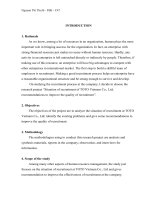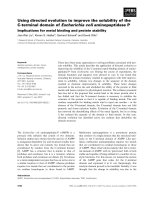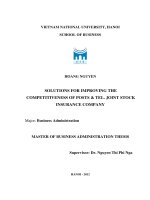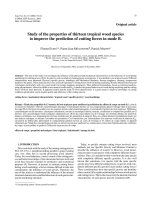Some marketing solutions to improve the competitiveness of confectionery products of hoang mai trading and production company limited
Bạn đang xem bản rút gọn của tài liệu. Xem và tải ngay bản đầy đủ của tài liệu tại đây (225.57 KB, 48 trang )
Graduation thesis
Academy of Finance
LIST OF ABBREVIATIONS
1. Hoang Mai Trading and Production Company Limited: Hoang Mai P&T
Co.,LTD
Student: Phung Thi Hai Yen
1
Class: CQ50/51.02
Graduation thesis
Academy of Finance
LIST OF TABLES AND CHARTS
1. Diagram 1: The management system of Hoang Mai Trading andProduction
Company Limited……………………………………25
2. Table 1: The income statement of Hoang Mai Trading and Production
3.
4.
5.
6.
7.
Company Limited 2013-2015 ……………………………………...30
Table 2: The rotatory of products of Hoang Mai P&T Co.,LDT……..32
Table 3 : Financial situation of Hoang Mai P&T Co.,LDT…………..34
Table 4: Product structure of Hoang Mai P&T Co., LTD…………….37
Table 5: Compare the price of competitor’s confectionery items…….41
Diagram 2: The distribution channel of Hoang Mai Trading and
Production Company Limited…………………………………............43
8. Table 6: Budget allocation of promotion tool of Hoang Mai Trading and
Production Company Limited…………………………………………44
INTRODUCTION
1. Rationale of the study.
Student: Phung Thi Hai Yen
2
Class: CQ50/51.02
Graduation thesis
Academy of Finance
After many years of economic reforms, Vietnam has strongly changed and
mobilized to market mechanism under the management of the Government. With
the open economy, enterprises can self-control their business. It is a good
opportunity for businessmen to control and develop their enterprises.
Fair trade enables vendors and manufacturers to offer the best products to a
broader array of customers and consumers. At the same time, it brings about
competition among business. It is, therefore, vital for companies to improve their
competitiveness in the race to earn their position in this open market. In order to
obtain the highest efficiency, companies need to consider their product’s quality,
the reputation of business, and trade condition. And companies have to find
ways to organize marketing activities effectively as well as improve
competiveness of enterprises. If they do not do marketing well, they will have a
lot of difficulties in their business activities, especially in the fierce competition
environment at present. In this situation, Hoang Mai Trading and Production
Company Limited has found that marketing is a good solution to associate and
create competitiveness for its company. Marketing activities not only attract
customers but also help company consume products better to improve the
efficiency of company.
From this view, I have studied about marketing and I would like to raise the
topic : “ Some marketing solutions to improve the competitiveness of
confectionery products of Hoang Mai Trading and Production Company
Limited”.
2. Aims of the study.
The study aims at:
Student: Phung Thi Hai Yen
3
Class: CQ50/51.02
Graduation thesis
Academy of Finance
Basing on situation of marketing activities of Hoang Mai trading and
production company limited, suggesting solutions to improve competitiveness of
the company.
3. Scope of the study.
As mentioned above, the thesis concentrates on the marketing solutions to
improve the competitiveness of the company. It focuses on collecting and
analyzing the figures from accounting department of the firm within three years,
from 2013 to 2015.
4. Methodology.
To achieve research objectives, I use the desk review method to research
and analyze.
5. Organization of the study.
The thesis includes the following contents:
Chapter 1: LITERATURE REVIEW
Chapter 2: THE STUDY
Chapter 3: R ECOMMENDATIONS
OUTLINE
DECLARATION
ABSTRACT
ACKNOWLEDGMENTS
LIST OF ABBREVIATIONS
LIST OF FIGURES AND TABLES
TABLE OF CONTENTS
INTRODUCTION
1.
Rationale of the study
2.
Aims of the study
Student: Phung Thi Hai Yen
4
Class: CQ50/51.02
Graduation thesis
Academy of Finance
3.
Scope of the study
4.
Methodology
5.
Organization of the study
CHAPTER 1: LITERATURE REVIEW
1.1 The basic definition and characteristics of marketing.
1.2 The major content of marketing activities in company.
1.3 Competition and the rationale of competition of the market
economy.
CHAPTER 2: THE STUDY
2.1 The development of company.
2.2 The operating outcome of company in recent years.
2.3 The real situation of marketing activities of company.
CHAPTER 3: RECOMMENDATIONS
3.1 The developing direction of company.
3.2 Solutions to improve competitiveness of company.
3.3 The supporting solutions.
DETAILED OUTLINE
Chapter 1: LITERATURE REVIEW
1.1
The basic definition and characteristics of marketing.
Student: Phung Thi Hai Yen
5
Class: CQ50/51.02
Graduation thesis
1.2
1.3
Academy of Finance
1.1.1 Definition.
From different viewpoints:
Philip Kotler
American Marketing Association (AMA)
Heidi Cohen
1.1.2 The characteristics of Marketing concept
1.1.3 The functions of Marketing
1.1.4 Researching and determining market needs
The major content of marketing activities in company
1.2.1 Choose target market and locate market
1.2.2 Market segment
1.2.3 Choose target market
Definition
Market segment valuation
Choose target market
Marketing strategies
The base of choosing marketing strategies
Marketing implementation and examination.
Competition and the rationale of competition in the market
economy.
1.3.1 Definition and the characteristics of competition.
1.3.2 The roles of competition in the market economy.
The roles of competition in service business.
The roles of competition to consumers.
The roles of competition in society economy.
Chapter 2: THE STUDY
2.1 The development of company.
2.1.1 The formation history and development of company
2.1.2 Human resources and human resources training.
2.1.3 The occupations of business registration and Field of business.
Student: Phung Thi Hai Yen
6
Class: CQ50/51.02
Graduation thesis
Academy of Finance
2.2 The operating outcome of company in recent years.
2.2.1 The operating outcome
2.2.2 The situation of organising business products.
2.2.3 The product circulation of company.
2.2.4 Financial statement of company.
2.3 The real situation of marketing activities of company.
2.3.1 Marketing strategy of company
2.3.2 Marketing solutions of company
2.3.2.1 Product policy
2.3.2.2 Price policy
2.3.2.3 Distribution policy
2.3.2.4 Mixed Promotion policy.
2.3.3 Market researching activity of company.
Chapter 3: RECOMMENDATIONS
3.1 The developing direction of company.
3.1.1 Target market and marketing objectives.
3.1.2 Competitive position of company in the market.
3.2 Marketing solutions.
Student: Phung Thi Hai Yen
7
Class: CQ50/51.02
Graduation thesis
Academy of Finance
3.2.1 Competitive strategy of company
3.2.2 Product strategy for target market
3.2.3 Price policy
3.2.4 Distribution strategy
3.2.5 Mixed promotion strategy.
3.3 The supporting solutions
3.3.1 Marketing organisation
3.3.2 The solutions of researching Marketing
Student: Phung Thi Hai Yen
8
Class: CQ50/51.02
Graduation thesis
Academy of Finance
CHAPTER 1: THE RATIONALE OF MARKETING IN BUSINESS
ACTIVITY.
1.1
The basic definition and characteristics of marketing.
1.1.1 Definition.
What does the term “marketing” mean? Marketing is often equated as
selling and advertising, and no wonder, we are bombarded with television
commercials, newspaper ads, direct mail campaigns, Internet pitches and sales
calls everyday. Although they are important, they are only two of many
marketing functions and are often not the most important ones.
According to American Marketing Association (AMA): “Marketing is the
activity, set of institutions, and processes for creating, communicating,
delivering, and exchanging offerings that have value for customers, clients,
partners, and society at large”.
Dr. Philip Kotler defines marketing as “The science and art of exploring,
creating, and delivering value to satisfy the needs of a target market at a profit.
Marketing identifies unfulfilled needs and desires. It defines, measures and
quantifies the size of the identified market and the profit potential. It pinpoints
which segments the company is capable of serving best and it designs and
promotes the appropriate products and services”.
Another view from Heidi Cohen-President, Riverside Marketing Strategies,
he defines: “Marketing is the process of getting a product or service from a
company to its end customers from product development through to the final sale
and post purchase support”.
In general, Marketing should be understood not in the old sense of making a
sale, but in the new sense of satisfying customer needs. Marketing is a process of
Student: Phung Thi Hai Yen
9
Class: CQ50/51.02
Graduation thesis
Academy of Finance
working with market to implement exchanges on the aim of satisfying customer
needs and demands.
1.1.2 The characteristics of Marketing concept.
1.1.2.1 Customer-orientation.
All business activities should be directed to create and satisfy the customer.
Emphasis on the needs and wants of consumers keeps the business on the right
track. All marketing decisions should be made on the basis of their impact on the
customer. Consumer becomes the guide of business.
1.1.2.2 Marketing Research.
Under the marketing concept; knowledge and understanding of customer’s
needs, wants and desires are very vital. Therefore, a regular and systematic
marketing research programme is required to keep abreast of the market. In
addition, innovation and creativity are necessary to match the products of
requirements of customers. Up-to-date and adequate knowledge must be
available to answer the following questions: (1)What business are we really in?,
(2)Who are our customers?, (3)What do the customers want?, (4)How should we
distribute our products?, (5)How can we communicate most effectively with our
customers?
1.1.2.3 Marketing Planning.
The marketing concept calls for a goal-oriented approach to marketing. The
overall objectives of the firm should be the earning of profits through satisfaction
of customers. On the basis of this goal, the objectives and policies of marketing
and other departments should be defined precisely. Marketing planning helps to
inject the philosophy of consumer-orientation into the total business systems and
serves as a guide to the organisation’s efforts.
Student: Phung Thi Hai Yen
10
Class: CQ50/51.02
Graduation thesis
Academy of Finance
1.1.2.4 Integrated Marketing.
Once the organisational and departmental goals are formulated, it becomes
necessary to harmonize the organisational goals with the goals of the individuals
working in the organisation. The activities and operation of various
organisational units should be properly coordinated to achieve the defined
objectives. The marketing department should develop the marketing mix which
is most appropriate for accomplishing the desired goals through the satisfaction
of customers.
1.1.2.5 Customer Satisfaction.
The aim should be to maximize profit over the long run through the
satisfaction of customer wants.
1.1.3 The functions of Marketing.
The ultimate aim of marketing is exchanging goods and services from
producers to consumers in a way that maximizes the satisfaction of customer’s
needs. Marketing functions start from identifying the consumer needs and end
with satisfying the consumer needs. The universal functions of marketing
involve buying, selling, transporting, storing, standardizing and grading,
financing, risk taking and securing marketing information. However, modern
marketing has some other functions such as gathering the market information
and analyzing that information. The assistance in product designing and
development also comes under the marketing functions. The marketing functions
have been discussed briefly: Market information, market planning, exchange
functions,
product
designing
and
development,
physical
distribution,
standardization and grading, financing, risk taking, packaging, labeling and
branding, customer support.
Student: Phung Thi Hai Yen
11
Class: CQ50/51.02
Graduation thesis
Academy of Finance
1.1.4 Researching and determining market needs.
Needs, wants and demands.
Needs: “The most basic concept underlying marketing is that of human
needs. Human needs are states of felt deprivation. They include basic physical
needs for food, clothing, warmth and safety; social needs for belonging and
affection; and individual needs for knowledge and self-expression. Marketers did
not invent these needs; they are a basic part of the human make-up”- Philip
Kotler et al, Marketing.
When a need is not satisfied, a person looks for an object that will satisfy it
or tries to reduce the need.
Wants : “Wants are the form human needs take as they are shaped by culture
and individual personality. Wants are shaped by one’s society and are described
in terms of objects that will satisfy needs. As a society evolves, the wants of its
members expand. As people are exposed to more objects that arouse their interest
and desire, producers try to provide more want-satisfying products and
services”- Marketing, An Introduction by Philip Kotler and Gary Armstrong.
Demands: People have narrow, basic needs, but almost unlimited wants.
However, they also have limited resources. Thus, they want to choose products
that provide the most satisfaction for their money. When backed by an ability to
pay – that is, buying power – wants become demands. Consumers view products
as bundles of benefits and choose products that give them the best bundle for
their money. Given their wants and resources, people demand products with the
benefits that add up to the most satisfaction.
Student: Phung Thi Hai Yen
12
Class: CQ50/51.02
Graduation thesis
Academy of Finance
The marketing offering: Products, services and experiences
Companies address needs by putting forth a value proposition, a set of
benefits that they promise to consumers to satisfy their needs. The value
proposition is fulfilled through a marketing offer– some combination of
products, services, information, or experiences offered to a market to satisfy a
need or want. Marketing offers are not limited to physical products.
Value, Expenditure and Satisfaction.
Consumers usually face a broad array of products and services that might
satisfy a given need. How do they choose among these many products?
Consumers make buying choices based on their perceptions of the value that
various products and services deliver. The guiding concept is customer value.
“Customer value is the difference between the values the customer gains from
owning and using a product and the costs of obtaining the product”- Philip
Kotler, Principles of Marketing.
Exchange, Transactions and relationships.
Marketing occurs when people decide to satisfy needs and wants through
exchange. According to Philip Kotler: “Exchange is the act of obtaining a desired
object from someone by offering something in return”. Exchange is the core
concept of marketing. For an exchange to take place, several conditions must be
satisfied. Marketing consists of actions taken to obtain a desired response from a
target audience towards some product, service, idea or other object. Transaction
marketing is part of the larger idea of relationship marketing. The concepts of
exchange and relationships lead to the concept of a market.
Markets
Student: Phung Thi Hai Yen
13
Class: CQ50/51.02
Graduation thesis
Academy of Finance
Modern economies operate on the principle of division of labour, where
each person specialises in producing something, receives payment, and buys
needed things with this money. Thus, modern economies abound in markets.
Producers go to resource markets (raw material markets, labour markets, money
markets), buy resources, turn them into goods and services, and sell them to
intermediaries, who sell them to consumers. The consumers sell their labour, for
which they receive income to pay for the goods and services they buy. The
government is another market that plays several roles. It buys goods from
resource, producer and intermediary markets, it pays them, it taxes these markets
(including consumer markets)and it returns needed public services. Thus, each
nation’s economy and the whole world economy consist of complex interacting
sets of markets that are linked through exchange processes.
Marketing and Marketer.
Considering market brings us full circle to the concept of marketing.
Exchange processes involve work. Sellers must search for buyers, identify their
needs, design good products and services, promote them, and store and deliver
them. Activities such as product development, research, communication,
distribution, pricing and service are core marketing activities. Company
purchasing agents do marketing when they track down sellers and bargain for
good terms. A sellers’ market is one in which sellers have more power and
buyers must be the more active ‘marketers’. In a buyers’ market, buyers have
more power and sellers have to be more active ‘marketers’. In the usual situation,
marketing involves serving a market of end users in the face of competitors. The
company and the competitors send their respective products and messages
directly to consumers or through marketing intermediaries to the end users.
Student: Phung Thi Hai Yen
14
Class: CQ50/51.02
Graduation thesis
Academy of Finance
1.2 The major content of marketing activities in company
1.2.1 Choose target market and locate market
Companies know that they can not satisfy all consumers in a given market
-at least, not all consumers in the same way. There are too many kinds of
consumer with too many kinds of need, and some companies are in a better
position than others to serve some groups of customers better. Consequently,
companies use market segmentation to divide the total market. They then choose
market segment and design strategies for profitably serving chosen segments.
This process involves market segmentation, targeting and positioning. From the
complexity of humans, it follows that there are many ways in which markets
segment, and finding a new way of segmenting markets or a new segment can be
the break through that creates a market success. Market targeting involves
evaluating each market segment’s attractiveness and selecting one or more
segments to enter.
1.2.2 Market segmentation
Definition: “Market segmentation consists of taking the total heterogeneous
markets for a product and dividing it into several sub-markets or segments, each
of which tends to be homogeneous in full significant aspects”- William
J.Stanton, Principles of Management and Administration.
Some requirements of market segmentation.
Measurability: Market segmentation has to ensure to measure scale,
purchasing power and characteristics of customers each segment.
Large-scale: These segments have to be enough large and have ability to
make profit. Market segment should be the largest and the most crowded,
deserving to carry out a separate marketing program.
Student: Phung Thi Hai Yen
15
Class: CQ50/51.02
Graduation thesis
Academy of Finance
Distinguishability: These market segments differ from definition and satisfy
differently with Marketing mix elements and various marketing programs.
Feasibility: Marketing activities have to contact with customers and have
enough human resources to develop, implement Marketing programs effectively
and attractablely, satisfy customer’s needs and wants in that segment.
The basis of market segmentation
Geographic segmentation: “ Geographic segmentation involves the
subdivision of a market into distinct geographical units such as national, state,
regional, country, city or neighborhood boundaries”- Writing a convincing
business plan by Arthur DeThomas,Ph.D; and Stephanie Derammelaere, M.B.A.
A company may decide to operate in one or a few geographical areas, or to
operate in all areas but pay attention to geographical differences in needs and
wants.
Demographic segmentation: Demographic segmentation consists of
dividing the market into groups based on variables such as age, gender, sexual
orientation, family size, family life cycle, income, occupation, education,
religion,
ethnic
community
and
nationality
(Armstrong
and
Philip
Kotler,2005:187).
Demographic factors are the most popular bases for segmenting customer
groups. One reason is that consumer needs, wants and usage rates often vary
closely with demographic variables.
Life-cycle segmentation (Age)- Offering products or marketing approaches
that recognize the consumer’s changing needs at different stages of their life.
Consumer needs and wants change with age. Some companies use age and life-
Student: Phung Thi Hai Yen
16
Class: CQ50/51.02
Graduation thesis
Academy of Finance
cycle segmentation, offering different products or using different marketing
approaches for different age and life-cycle groups.
Ethnic segmentation: The multi-ethnic communities define market
segments for all manner of goods. The communities also nurture businesses that
appear beyond their own ethnic boundaries.
Gender segmentation: is usual in clothing, hair dressing, cosmetics and
magazines. Recently, marketers have noticed other opportunities for gender
segmentation.
Income segmentation- Dividing a market into different income groups
Income segmentation is often used for products and services such as cars,
boats, clothing, cosmetics and travel. Many companies target affluent consumers
with luxury goods and convenience services.
Geodemographics- The study of the relationship between geographic
allocation and demographics.
Geodemographic segmentation is based on two simple principles:
People who live in the same neighborhood are more likely to have similar
characteristics than are two people chosen at random.
Neighborhoods can be categorized in terms of the characteristics of the
population which they contain. Any two neighborhoods can be placed in the
same category. They contain similar types of people, even though they are
widely separated.
Psychographic segmentation: Psychographic segmentation divides buyers
into groups based on social class, lifestyle or personality characteristics.
Psychographic segmentation is one which uses people’s lifestyle, their
activities, interests as well as opinions to define a market segment.
Student: Phung Thi Hai Yen
17
Class: CQ50/51.02
Graduation thesis
Academy of Finance
Some factors which help divide a population based on psychographic
segmentation: Lifestyle, activities interests and opinions, values attitudes and
lifestyle, social class, personality,…Overall, these factors are intangible in nature
and need in depth market research to determine which lifestyle or social class to
target.
Choose target market
Definition: “A target market is the market segment on which an
organisation focuses its marketing plan and to wards which it directs its
marketing efforts”- Irma Mckinlay, Maria O’Connor, Sara Ross, FCS Marketing
L2.
Market segment valuation: The scale and growth of market segment:
Choosing big market segment or small market segment refers to ability and
human resources of enterprises. Enterprise needs to collect and analyze these
figures: Sales, profit and how profit change.
Choose target market: There are 5 ways of selecting target market:
Concentrating on market segment, specializing selection, specializing according
to product, specializing according to market, covering total market.
Marketing strategies:
Definition: “An organization's strategy that combines all of its marketing
goals into one comprehensive plan. A good marketing strategy should be drawn
from market research and focus on the right product mix in order to achieve the
maximum profit potential and sustain the business. The marketing strategy is the
foundation of a marketing plan”- in the view of Christina Motley.
Developing a marketing strategy is vital for any business. Without one, the
efforts to attract customers are likely to be haphazard and inefficient. The focus
Student: Phung Thi Hai Yen
18
Class: CQ50/51.02
Graduation thesis
Academy of Finance
of the strategy should be making sure that the products and services of company
meet customer needs and developing long-term and profitable relationships with
those customers. To achieve this, company will need to create a flexible strategy
that can respond to changes in customer perceptions and demand. It may also
help company identify whole new markets that you can successfully target.
The base of choosing marketing strategy: One of the key elements of a
successful marketing strategy is the acknowledgement that company’s existing
and potential customers will fall into particular groups or segments, characterised
by their "needs’. Your strategy must take account of how your business' strengths
and weaknesses will affect your marketing. With an understanding of your
business' internal strengths and weaknesses and the external opportunities and
threats, you can develop a strategy that plays to your own strengths and matches
them to the emerging opportunities. You can also identify your weaknesses and
try to minimise them. The next step is to draw up a detailed marketing plan that
sets out the specific actions to put that strategy into practice.
Marketing implementation and examination.
Organizing implementing marketing is the process of transforming the
marketing strategy and program of marketing activities in order to actually
achieve the marketing objectives set out in an effective way. While the analysis
and the plan of marketing strategy is to identify clearly what and why of
marketing activities, the implementation aimed to find answers: who, where,
when, and how to turn strategic ideas become reality.
The mission of the marketing department is to plan, implement and test
marketing. A marketing plan is designed perfectly whether it is, it may still arise
many problems to solve in the implementation process, so the marketing
Student: Phung Thi Hai Yen
19
Class: CQ50/51.02
Graduation thesis
Academy of Finance
department must regularly monitor and test marketing activities. When the
systems examine if marketing works well, it will ensure in particular for
marketing activities and business activities of enterprises in general achieve
goals with greater efficiency.
1.3 Competition and the rationale of the market economy.
1.3.1 Definition and the characteristics of competition.
Definition: “Rivalry in which every seller tries to get what other sellers are
seeking at the same time: sales, profit, and market share by offering the best
practicable combination of price, quality, and service. Where the market
information flows freely, competition plays a regulatory function in balancing
demand and supply”- German Wilches.
Characteristics of competition:
Scarcity as a condition of competition: Wherever there are commonly
desired goods and services, there is competition. In fact, economics starts with its
fundamental proposition that while human wants are unlimited the resources that
can satisfy these wants are strictly limited. Hence people compete for the
possession of limited resources: Competition is continuous, competition is a
cause of social change, competition may be personal or impersonal, competition
is always governed by norms.
1.3.2 The roles of competition in the market economy.
The roles of competition in service business:
Competition is a majeure thing in the market economy. Entrepreneurs and
businesses have to accept competition when they join in market. Competition
can be considered a fierce race that businesses can not parry and find the best
ways to take the lead. Hence, competition forces businessmen to find the ways to
Student: Phung Thi Hai Yen
20
Class: CQ50/51.02
Graduation thesis
Academy of Finance
improve service quality, best satisfy the needs and wants of customers as well
market. Because of high competitive pressure, businesses run efficiently.
The roles of competition to consumers.
Thanks to competition, the consumers receive more favourable and
diversified service quality. The service quality is enhanced while the expense
reduces. Competition also protects consumer’s own interests.
The roles of competition in social economy.
For the social economy, competition plays an important role:
Competition is the motivation of developing economy, improving the
quality of society services. Competition creates the innovation, brings stronger
growth, helps to eliminate unreasonable monopoly and inequality on business.
Besides, competition also brings disadvantages. Market mechanism forces
businesses to participate to compete and exist. This requires Government’s
management to make sure the enterprises can free compete effectively.
Student: Phung Thi Hai Yen
21
Class: CQ50/51.02
Graduation thesis
Academy of Finance
CHAPTER 2: ANALYZING THE MARKETING ACTIVITIES OF
HOANG MAI TRADING AND PRODUCTION COMPANY LIMITED
2.1 The development of company.
2.1.1 The formation history and development of company.
Hoang Mai Trading and Production Company Limited was found in
October 2001 by the certificate of business registration No. 0102003620 by
Department of Planning and Investment in Hanoi, originally located at 48 Hang
Tre, Hoan Kiem District, Ha Noi, Viet Nam. In October 2005, head office were
moved to 40 Tran Nhat Duat, Hoan Kiem District, Ha Noi. In April 2011, the
company moved to Office 9th Floor, HCMCC Tower office building, 249A Thuy
Khue Street, Tay Ho District, Hanoi. The company exclusively imports and
distributes high quality confectionery products (cookies, biscuits, cake and
candy) in Viet Nam. Business products are distributing nationwide by systems of
regional distributors and supermarkets (Metro, Big C, Saigon corp, Intimex,
Hapro) and retailers. In 2011, the company just imported Apollo products
which made in Malaysia. After 1 year, the company developed 15 ranges of
product, for example Apollo, Rinda Gula candy and KokocChocolate from
Malaysia, or Crow-pie from Korea, Nissin Cookies from Indonesia. From 2003
to 2004, the company added 21 ranges, it made the total of 36 ranges of product
Student: Phung Thi Hai Yen
22
Class: CQ50/51.02
Graduation thesis
Academy of Finance
from 8 producers. By 2005, the company increased to 60 ranges of product. The
company enlarged business over Europe, Midle East, and it were exclusive sales
agent for Montresor - Belgium, Euro cake - UAE, Chocolate Socado – Italyin
2006. From 2007 to 2015, the company developed other ranges of products from
other industries such as Nabisco, Montresor, Dofreeze, Rinda Food.
2.1.2 Human resources and human resources training.
The management committee of the company includes 1 general manager, 1
deputy managing director and 1 chief accountant.
Some departments of
the company such as The department of chief
accountant, The sales department, The department of import and export, The
marketing department, The department of administrative and human resources,
Warehouse: Dien warehouse, Trieu Khuc warehouse, Ngoc Lam warehouse.
Functions and mission of each department:
(1) General manager: Nguyen Thi Tuyet Mai.
General manager directly operates and manages the entire business
activities, takes responsibility of the company’s outcome, represents the entire
interest of all staff and employees in the company, assigns tasks to deputy
managing director and also takes responsibility for the tasks assigned to the
Deputy Managing Director.
(2)The deputy managing director: Nguyen Thi Huong.
The deputy managing director counsels and supports General Manager, has
responsibility for assigned missions. On behalf of General Manager to manage
entire business activities.
(3) The department of human resources.
Student: Phung Thi Hai Yen
23
Class: CQ50/51.02
Graduation thesis
Academy of Finance
The department of human resources arranges staff, adjusts wage, rewards,
disciplines, admits or transfers job, dismisses, establishes training plans for staff
and acquires policy regime of the State to ensure the rights and obligations of
workers.
(4) The accounting department.
The accounting department monitors transactions arising within the
company, after that proposes measures to ensure and strengthen the financial
management of the unit and promote the efficient use of capital. The accounting
department manages assets, examines and assesses periodically on the aim of
timely processing of damaged assets, closely examines the cash collection in the
company. Chief Accountant is responsible for the law for accounting regulations,
statistics, financial management of the company.
(5) The sales department.
The sales department finds customers, partners and markets, receives and
signs economic contracts. The sales department acts as an advisor for General
Manager on the production and business activities in the company. The business
department is divided into 2 units such as the supermarket business unit and the
distributor business unit.
(6) The department of import-export.
The department of import-export takes responsibility for customs
procedures and insurance procedures to export domestic goods and import goods
from other countries. In addition, the department of import-export also
undertakes to keep foreign relations with other companies.
(7) The marketing department.
Student: Phung Thi Hai Yen
24
Class: CQ50/51.02
Graduation thesis
Academy of Finance
With the main task of developing image and brand of company, bringing the
company's image closer to consumers, The marketing department undertakes to
hold fair, carries out televised advertisement, advertises through billboard
system.
(8) The administrative and customer service department.
This department controls the whole network system of company, all
accounting software and all business information. The admin department keeps
information as secret and updates continuously. Besides, the admin and customer
service department has to get customer’s opinion as well as answer customer’s
questions. This helps to improve customer service quality.
(9) Warehouses
The company has three warehouses, including Dien warehouse, Trieu Khuc
warehouse and Ngoc Lam warehouse. The stretch of warehouse system is a
convenience for the distribution of goods to all provinces.
Warehouses are assigned to examine and monitor the import-export
situation of finished product and goods of company as well as implement importexport procedures and other related documents.
2.1.3 The occupations of business registration and Field of business.
The occupation of business registration of the company includes agent,
intermediary, auction; Wholesale food; Production of confectionary;
Transportation of goods by road; Packing service; Warehousing and storage of
goods; Short-stay services and Wholesale supplies for the family.
However, the company focuses on the industry that brings high turnover
such as confectionery, freight by automobile, warehousing operations, food
manufacturing and packaging of confectionery.
Student: Phung Thi Hai Yen
25
Class: CQ50/51.02









